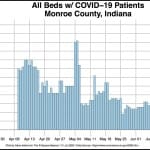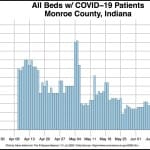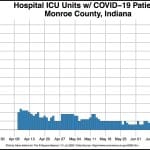Monroe County board of health elevates COVID-19 health order to regulation status: $500 fine possible




A regulation adopted unanimously by Monroe County’s board of health on Tuesday night is based largely on same the wording of an order issued late last week by county health officer Thomas Sharp. Both are meant to help prevent the spread of the COVID-19 virus.
The regulation takes effect at noon on Wednesday, July 22, but puts off some of the requirements until July 31. The requirement on face coverings is effective at noon, Wednesday, sooner than the other requirements. That sequence follows the same pattern as the health order did, which was issued last week.
In practical terms, the regulation has a status that allows for enforcement and punishment with a fine. Under the county code, the violation of a board of health regulation is a Class C ordinance violation. And a Class C ordinance violation carries with it a possible fine of up to $500. [Updated 11:11 a.m. on July 22, 2020. The board of county commissioners adopted an executive order at their regular meeting directing the sheriff to enforce the health board’s regulation.]
But the regulation approved Tuesday recommends that individuals, as opposed to groups, be fined $50. Group violations are recommended to be fined at a higher, unspecified amount.
The county regulation on wearing a face covering is something that can be enforced less than 24 hours after it was approved by the board of health on Tuesday evening.
The face covering regulation goes into effect on noon Wednesday. Starting then it can be enforced by health department officials and any law enforcement officer—sheriff’s deputies, Bloomington police, Stinesville police, and Indiana University police among others, according to county attorney Margie Rice.
Even if fines for lack of a face covering can start at noon Wednesday, other county requirements are not set to go into effect until July 31 at noon. Those include requirements on crowd size—for non-commercial gatherings (50 people) and commercial gatherings (100 for indoors and 150 outdoors). The requirements that are set to begin July 31 also include a prohibition against bar-top service in restaurants.
Monday’s order issued by Bloomington’s mayor, John Hamilton, does not impose restrictions that are any different from the county’s order, but accelerates the timing for those parts of the county’s mandate that are set by the county to go into effect on July 31. The mayor’s order puts those other requirements into effect on July 23.
It’s not clear how Bloomington will enforce the mayor’s order—on crowd sizes and bar-top service—from July 23 until the county’s regulation on those subjects takes effect on July 31. The answer to a late afternoon query on the topic from The Square Beacon was deferred by communications director Yael Ksander to the city’s legal staff: “I would not want to respond without their expertise.”
As soon as Wednesday at noon, because the county’s regulation makes the wearing of face coverings mandatory starting then, Bloomington police officers could issue tickets under the regulation, according to Rice.
At Tuesday night’s board of health meeting, health administrator Penny Caudill was asked about the decision on timing: Why wait until July 31?
Caudill said the timing was based on an interest in giving the business community and her own department time to prepare. “We knew that in talking with businesses, … some of them would need some time to meet some of the guidelines,” Caudill said. She added, “There are some bars for example, that may not have the tables and chairs that they would need to operate—they may need to get them.”
About her own department’s preparations, Caudill said waiting until July 31 was important, “…just for us to be prepared to deal with exemptions, to be prepared to deal with the influx of potential complaints, which we’ve already been dealing with.” Even the existing health order, Caudill said, “has created a lot of issues for us internally—we knew that an order like this would increase those.”
Health department officials and law enforcement officers can write tickets for the infraction, county attorney Margie Rice said at the board of health’s meeting. The tickets will be like those issued for animal management infractions, with four parts, Rice said: one goes to the person who receives the ticket; one stays with the law enforcement officer; one goes to the county attorney’s office, and one goes to the ordinance violations bureau.
Rice said at the board of health’s meeting, “We specifically wanted to make sure that we told the world that local and state law enforcement agencies could enforce this.”
But rank-and-file individuals can’t enforce the regulation, Rice said, pointing to wording in the regulation itself: “Nothing in this regulation gives individual residents the authority to intimidate or harass individuals who do not voluntarily comply or who are found out of compliance with this regulation.”
Prompting the county’s order, which is stricter that the governor’s current COVID-19 order, is a provision in state law, Rice said. That provision says “a person shall not institute, permit or maintain any conditions that may may transmit, generate or promote disease,” according to Rice.
That means there’s a public health interest in preventing individual people from transmitting the COVID-19 virus, Rice said. Monroe County’s numbers are going the wrong direction, according to Rice. She gave the same statistic that Brian Shockney, president of IU Health’s south central region, had provided at a press conference last Friday: Hospitalizations had tripled over the previous week.
Hospitalization numbers for Monroe County were up around 50 cases late last week, which is as high as they were at their peak in late April and early May. The numbers and ebbed to around 45 over the weekend.
As of Monday, the total number of confirmed COVID-19 cases in Monroe County was 490. As one measure of the recent surge, half of Monroe County’s COVID-19 cases have been confirmed since June 29. That means in the last three weeks, the same number of cases have been confirmed positive as in the 14 weeks before that, starting with the first confirmed case on March 21.
The more recent positive cases are skewed towards younger age brackets. In the six days before Sunday, of the 111 confirmed positive cases in Monroe county, 63 of them (57 percent) were in people younger than 29.
Monroe County has not added to its 28 COVID-19 deaths in almost a month—the last one was recorded on June 21.
At Tuesday’s board of health meeting, Rice also pointed out that the resumption of Indiana University fall classes means that Bloomington will soon have a large influx of new people in town.
About the influx of students, county health officer Thomas Sharp said at the board’s meeting that he expects the number of positive cases to increase as a result: “We expect it to go up, or I do anyway, after the students get back, because their non-compliance [with face covering guidance] is astounding.”
Board of health member Mark Norrell asked about the kind of data that might support the possibility of re-imposing a local stay-at-home order. Such an order would presumably resemble Indiana governor Eric Holcomb’s earlier Hunker Down Hoosier order, but only on a local level.
Caudill said the sort of data that goes into those kind of decisions includes hospitalizations and the capacity of hospitals. The question is, Caudill said: Can hospitals take care of the people who are sick, along with the additional cases of COVID-19 that are being identified? An other question cited by Caudill: Can all the contact tracing and interviews that go along with that be done?
Caudill said she’d just reached out to Indiana University about criteria for IU to consider that might help decide if there’s a need for IU to delay its reopening plans.
For his part, health officer Thomas Sharp said he did not think a local stay-at-home order is likely. “There’d have to be extraordinary circumstances to do that, because it’s been such a disaster—mentally, emotionally, psychologically, financially, everything else for everybody.”
Sharp added, “And if there’s any question, look at the rate of suicide, rate of alcohol use, rate of drugs use.” Sharp said it would need to be something extraordinary “to go backwards significantly” on the lifting of the stay-at-home order.




Comments ()